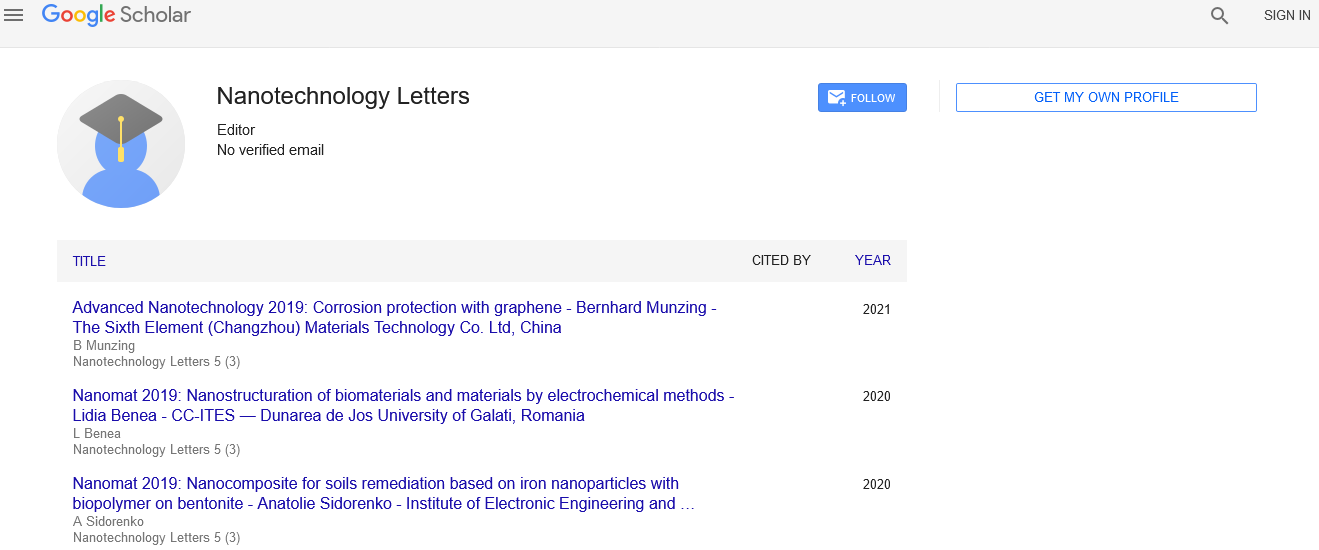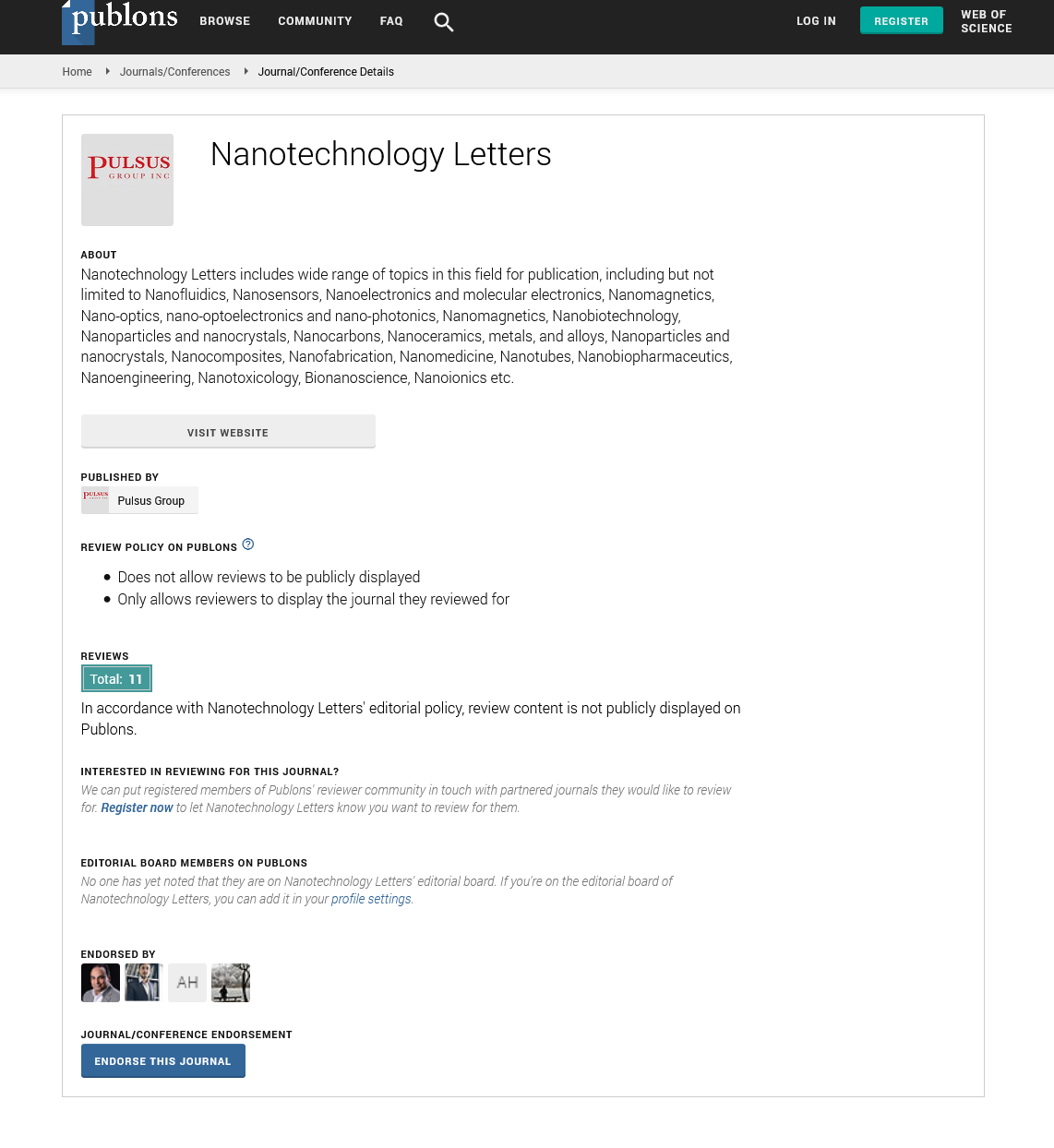Pharmaceutical Nanotechnology and Nanomedicine
Received: 01-Mar-2022, Manuscript No. pulnl-22-4754; Editor assigned: 05-Mar-2022, Pre QC No. pulnl-22-4754(PQ); Reviewed: 19-Mar-2022 QC No. pulnl-22-4754(Q); Revised: 24-Mar-2022, Manuscript No. pulnl-22-4754(R); Published: 27-Mar-2022, DOI: 10.37532. pulnl-22.7.(2).1-2.
Citation: Hoffman A. Pharmaceutical nanotechnology and nanomedicine. Nanotechnol Lett. 2022; 7(2):1-2.
This open-access article is distributed under the terms of the Creative Commons Attribution Non-Commercial License (CC BY-NC) (http://creativecommons.org/licenses/by-nc/4.0/), which permits reuse, distribution and reproduction of the article, provided that the original work is properly cited and the reuse is restricted to noncommercial purposes. For commercial reuse, contact reprints@pulsus.com
Abstract
The junction of nanotechnology and life is referred to as nanobiotechnology, bionanotechnology, and nanobiology. This field aids in identifying the intersection of biological study and other fields of nanotechnology. Nanodevices (such as biological machines), nanoparticles, and nanoscale phenomena that occur under the subject of nanotechnology are all concepts that are strengthened by nanobiology. Scientists can imagine and build systems for biological research using this technical approach to biology. Biologically inspired nanotechnology is based on biological systems as a source of inspiration for yet-to-be-developed technologies.
Perspective
Pharmaceutical nanotechnology is concerned with the development of personalised drug delivery systems using emerging technological technologies. The rate of absorption, distribution, metabolism, and excretion of the drug or other relevant chemical components in the body is influenced by the drug delivery mechanism. Furthermore, the drug delivery method enables the medication to attach to its target receptor and alter the signalling and activity of that receptor. Pharmaceutical nanotechnology includes nanomaterials and devices for drug delivery, diagnostics, imaging, and biosensors, as well as applications of nanoscience to pharmacy as nanomaterials.
With the extraordinary advancements in biomedical nanotechnology over the last few decades, traditional Drug Delivery Systems (DDSs) have been transformed into smart DDSs that respond to stimuli. Those well-defined nanoplatforms can boost therapeutic targeting efficacy while reducing side effects/toxicities of payloads, which are crucial factors for enhancing patient compliance, by responding to specific internal or external triggers. A wide range of smart DDSs have been proven in the academic sector for a number of fascinating systems, including stimuli-responsive polymeric nanoparticles, liposomes, metals/metal oxides, and exosomes. Nanopharmaceuticals have the potential to identify diseases at an earlier stage, and diagnostic applications based on nanoparticles could be developed. Nanopharmaceuticals are a new field in which the size of a drug particle or a therapeutic delivery system is controlled at the nanoscale. The challenge of delivering the proper dose of an active medication to a specific illness location has long been a problem in the pharmaceutical industry. Traditional therapies, which offer site-specific targeting of active drugs, have failed to solve this problem. Nanopharmaceuticals have immense potential in overcoming this failure. Precision targeting using nanopharmaceuticals lowers hazardo--us systemic side effects and improves patient compliance. In today's global economy, pharmaceutical companies are under tremendous pressure to provide high-quality drugs to patients while remaining profitable. As a result, pharmaceutical companies are turning to nanotechnology to help them improve or complement drug target research and delivery. Nanopharmaceuticals lower the cost of drug discovery, design, and development while also improving medication delivery. As a result, the success rate of research and development improves, allowing for the faster introduction of innovative, cost-effective products to the market. Novel Drug delivery system is an advanced drug delivery system that improves drug potency, regulates drug release to offer a long-lasting therapeutic impact, increases safety, and finally targets a drug to a specific tissue. Graphene-based materials, such as pristine graphene sheets, few-layer graphene flakes, and graphene oxide, have a wide range of unique, adaptable, and customizable features that can be used in biomedical applications. There are several graphene uses in biomedicine, which can be divided into three categories: transportation (distribution) systems, sensors, tissue engineering, and biological agents (for example antimicrobials). Graphene and 2D materials have the potential to generate unique and breakthrough medical gadgets that could improve healthcare. Ex vivo and in vivo data on patient- and disease-specific variables are used in personalised medicine to personalise chemotherapy therapies. Patients who are likely to respond to nanomedicine-based therapeutic interventions can be pre-selected by noninvasively visualising how well image-guided nanomedicines-that is, submicrometer-sized drug delivery systems containing both drugs and imaging agents within a single formulation and designed to more specifically deliver drug molecules to pathologic sites-accumulate at the target site. Furthermore, drug doses and treatment procedures can be personalised and optimized during follow-up by longitudinally evaluating how well patients respond to nanomedicine-based therapeutic treatments. Noninvasive imaging data on the buildup of nanomedicine formulations in possibly endangered healthy tissues could also be utilised to rule out patients from future treatment. As a result, combining noninvasive imaging with tumor-targeted drug delivery appears to have a lot of promise for customising nanomedicine-based chemotherapeutic treatments and getting the right drug to the right patient at the right time.
Nanoparticles can be synthesized in two ways for pharmaceutical applications such as medicine manufacture. Bottom-up procedures that use hydrophobic molecules like liposomes as bases to mount pharmaceuticals include pyrolysis, inert gas condensation, solvothermal reaction, sol-gel manufacture, and structured media. Attrition/milling is a top-down method that involves chipping down the medicament to create a nanoparticle. Medication distribution is an important aspect of pharmaceutical sciences that should be considered early on in the drug development process. A medicine that can't go to where it needs to go is essentially ineffective.
The physico-chemical properties of the drug and formulation, as well as the interaction of these parameters with drug transport, binding, and metabolism in the body, influence drug delivery. New techniques are needed to reliably anticipate the delivery properties of compounds early in the drug development process, so that the best molecules for clinical trials can be identified. Another type of tool is delivery systems, which make it easier to get hard-to-deliver chemicals to the right target areas. In pharmaceutical science, delivering gene-based therapeutics and proteins is a huge difficulty. In these tough circumstances, nanotechnology can help improve medicine delivery. CDR is focused on the creation and application of nanoparticles in the formulation of these sorts of medications, and we encourage fruitful industrial partnerships to help us develop these technologies for translational usage.






